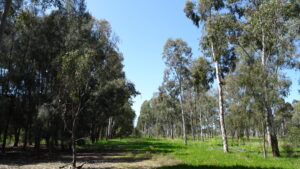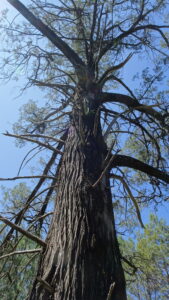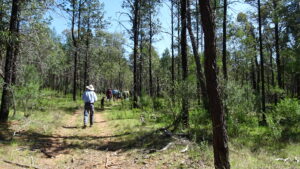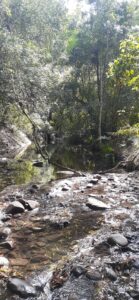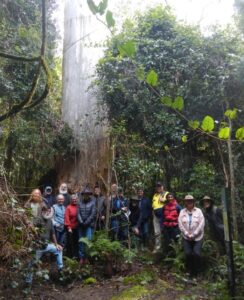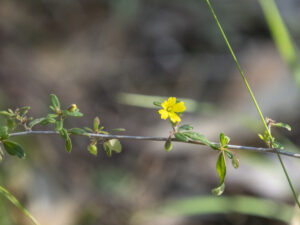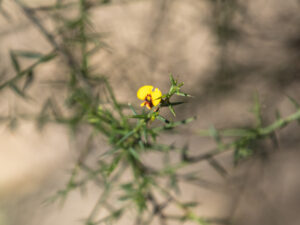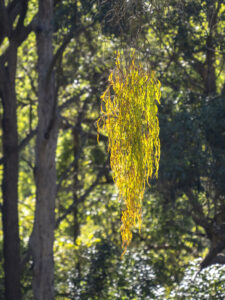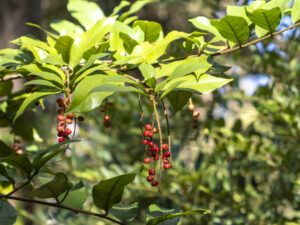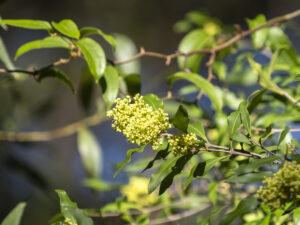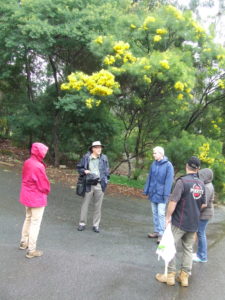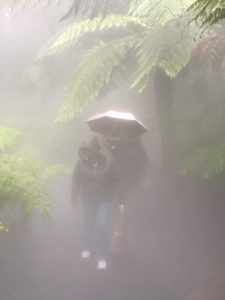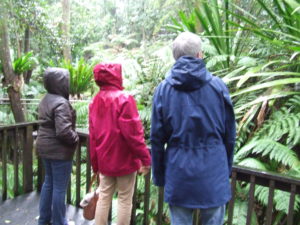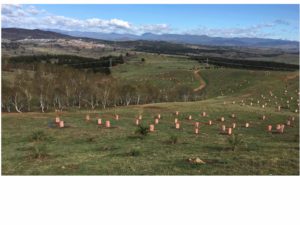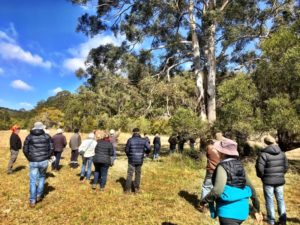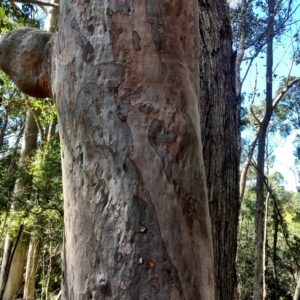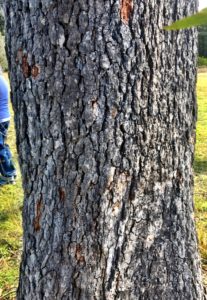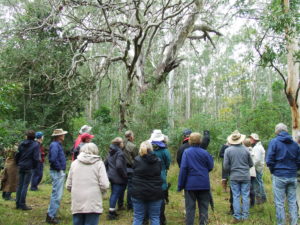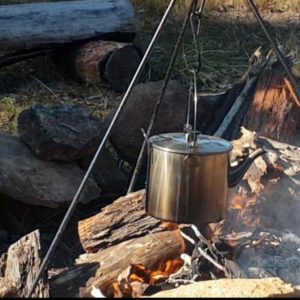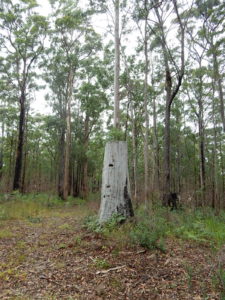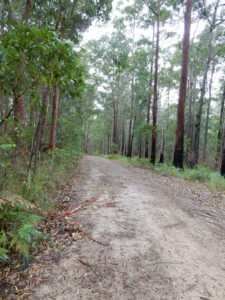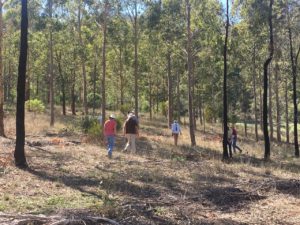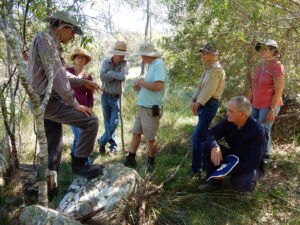Field Days 2018 – 2024
Western Tour October 2024
HFFN donned their hats and boots and headed west for a weekend of trees, plantations and comradery. We were privileged to spend time at two vastly different forests.
Michael and Jane at Quirindi have spent 20 years planting, nurturing and managing plantations of Chinchilla Eucalyptus and Paulownia. The plantation of Paulownia in full bloom provided visual treat as we entered the property. 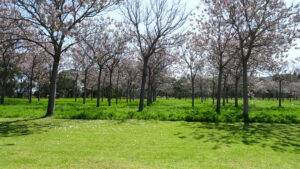
Jan told us that in the early days, Michael needed to continue his illustrious teaching career while Jan busied herself planting 80 trees a day! Someone noted that Micheal had to slave away in airconditioned comfort while Jan was able to enjoy the hot sun….just sayin’…
It was a great privilege to be able to tap into Jan and Michael’s knowledge, to walk amongst the tress talking about pruning, thinning, looser trees, water strategies and milling.
A BBQ dinner at the 7-star John Oxley caravan park gave us plenty of time to discuss the days teachings and to prepare for the following day at Eric’s. Of course, the conversation became more profound as the wine bottle emptied.
Coonabarabran provided a wonderful opportunity to see Eric & Elise’s vast forest of Ironbark and Cypress. Where you literally couldn’t see the forest for the trees.
Eric and Elise earn a large part of their living from the trees they harvest and mill. We talked a lot about their need to find a productive use for everything they extract from the forest
Eric’s forest provides a stunning contrast to Jan and Michael’s. Jan and Michael have been precise in their row setup and preparation, the watering and pruning. Whereas Eric is managing with a natural forest. He deals with the trees as, when and where they appear. He needs to constantly make decisions about which trees to thin, which to nurture.
Back at the main shed, discussion soon turned to milling timber. Eric operates a large Wood-Mizer bandsaw mill. Micheal and Nevell both have smaller Australian Hardwood mills and Phil has the ubiquitous Lucus mill.
Some of the non-millers in the group found discussion about Elise’s fine woodwork much more enlightening.
Overall, knowledge was shared, delicious morning teas were enjoyed and good company abounded.
Chichester September 2024
Orchids in trees and a beautiful creek. Towering Casuarinas, much taller than the average. Covered in Orchids of all kinds – including rock orchids!? The brains trust identified all the plants as we wandered along a gorgeous part of the creek. Management issues were forgotten when crossing the creek someone slipped off a rock and gave an eel a big fright.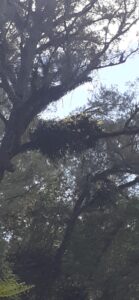
Barrington (Salisbury) August 2024
Tocal Field Days 2024
We escaped the really bad weather, the crowds were large and we had lots of very interesting conversations. A great three days with many new contacts.
Brunkerville May 2024
A peaceful walk amongst a surprising large and beautiful forest. We were given some wisdom on managing a small holding and some thoughts on life. Lots of social contact and sharing experiences. We put together a short form plant list for the owner. Thanks to Heather for the photos.
Dungog March 2023
Just escaping a large rain event, we walked along the river, managing to avoid the fast flowing water. The subject was a proposed riparian revegetation project. Our master was bush-regenerator expert Peter Dixon from Peter Dixon Consulting bushregenerator@outlook.com. Inspiring on what could be achieved and what a small group of volunteers are hoping to get going soon.
Tocal Field Days 2023
HFFN volunteers manned a stand in the LLS community marque. For the three days. Lots of interest and this year, LOTS of people.
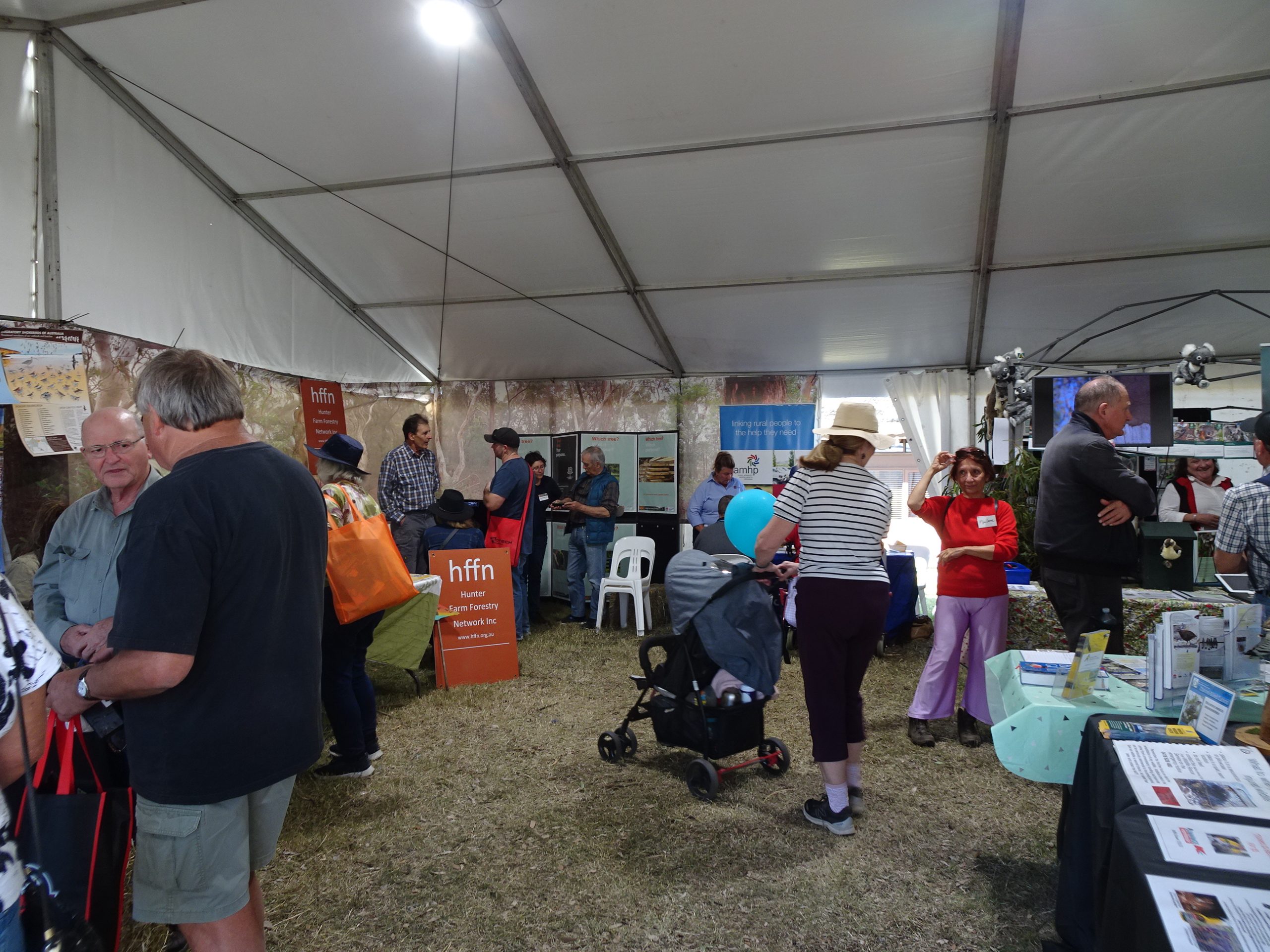
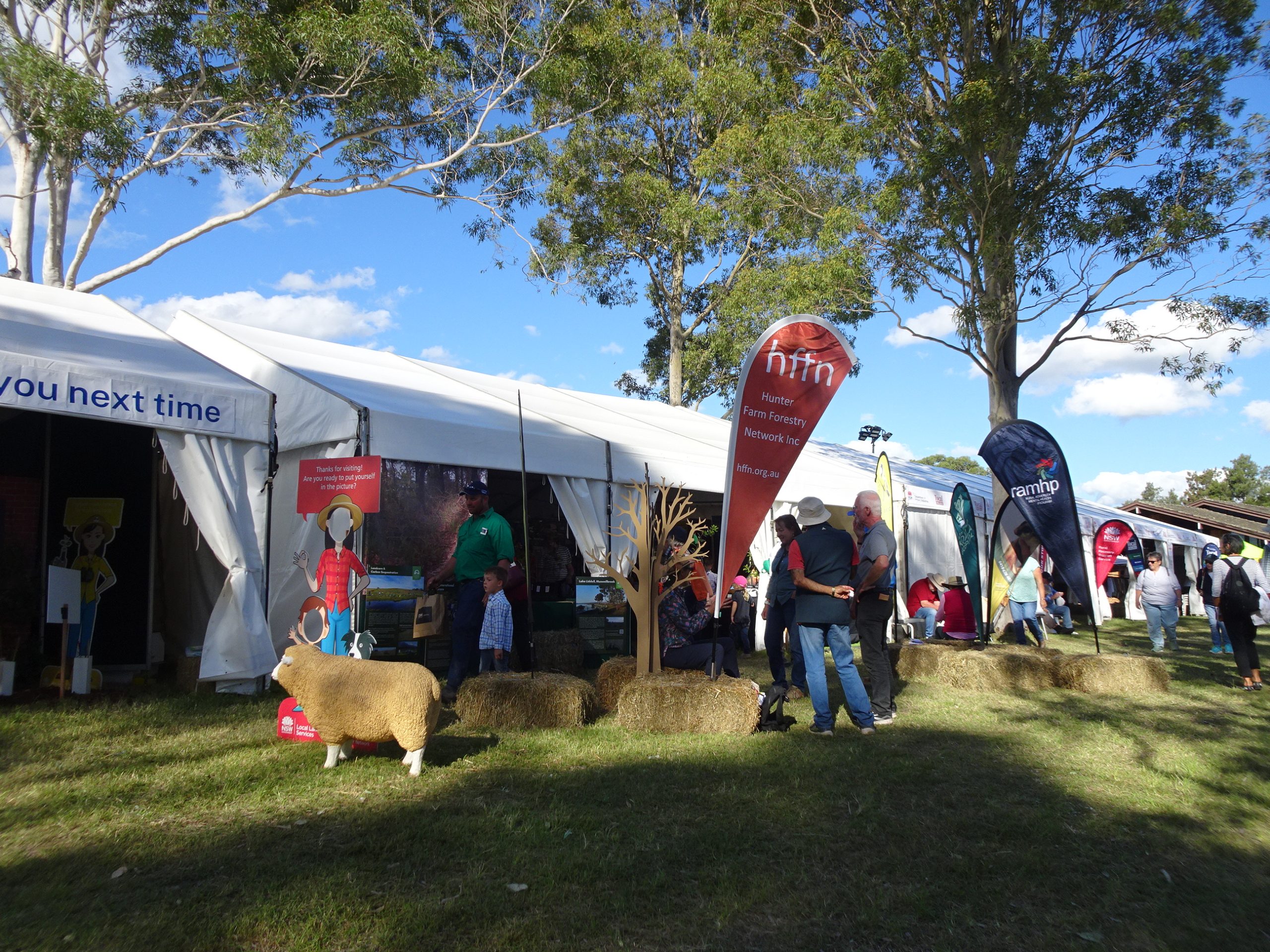

Goorangoola June 2023
HFFN was invited by the local land care group to talk about controlling Eucalypt regrowth. After the very wet three years, 2020 – 2022, regrowth is occurring in many parts. We walked through regrowth from the past three years and also from wet years in 2007 and 1974. Paddocks that were previously cleared are now too think to ride a bike through. Thinning options were discussed and demonstrated. The legal requirements of the bio-diversity and forestry regulations were explored by the LLS representatives. All complicated by the presence of a research project on the Brush Tailed Phascogale.
Wootton June 2023
A well attended day with several new members who joined after our Tocal field days. A walk through the basics of plantation and forest management with Craig for those who needed the introduction and reminders. Plenty of advanced questions for those who could absorb the detail.
Dungog July 2023
A great Day at the saw mill!!? Annabel and James from Australian Sustainable Timbers Australian Sustainable Timbers showed us through their (very) new saw mill at Dungog. Great discussion on milling, a small demonstration on sawing with the part of the mill that was complete and much discussion on timber qualities out in the log yard.
Booral August 2023
A day walking through an inspiring forest with Steve Dobbyns Home (jamaxforestsolutions.com). Talking as we walked about forestry regulations. about what could be done if the landholder wished to take out some of the great trees in his patch.
Krambach August 2022
With a wonderful view and wet but highly social start, we were given a great insight into the landslip problems and subsequent geotechnical investigations and repairs. The recent rain has also unleashed a further landslip which was still not repaired, so the education cycle was complete. A great walk with some very nice regrowth forest and more great views from the top.
Great to see a land manager with a scientific approach. A wonderful property. Thanks.
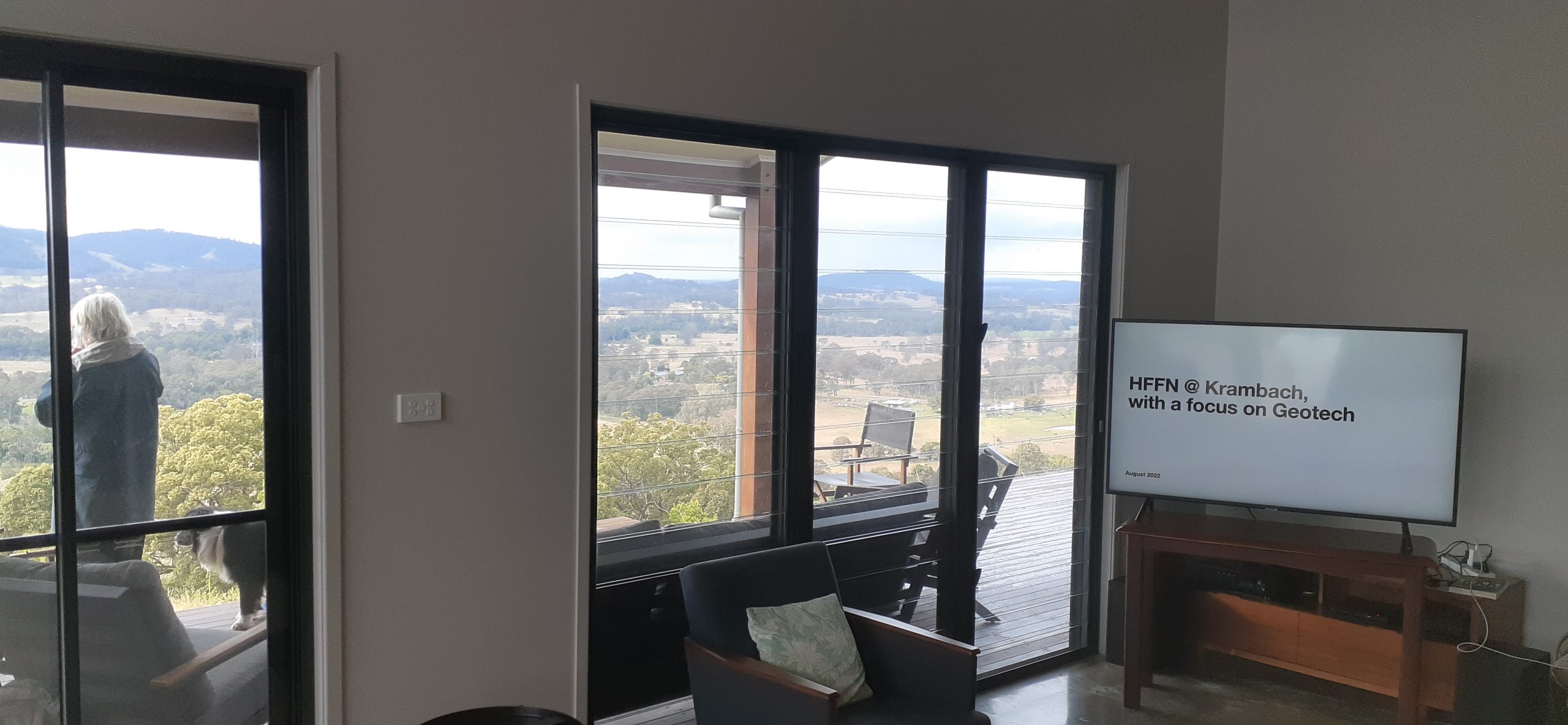
Monkerai May 2022
After the cold weather, never-ending rain and COVID isolation, it was pretty darn nice for 25 HFFN members to come together in the Upper Monkerai Valley for a Field Day on 29 May.
Our venue, the Black Bulga community, is a 53 hectare property at the confluence of the Karuah and Tellegherry Rivers. The block is heavily forested, with 45 year-old regrowth forest.
The field day began by acknowledging the Traditional Owners of the Monkerai Valley, the Worimi and Biripi peoples. HFFN President Judy Boyden welcomed members and provided a safety briefing. Black Bulga members James and Jack spoke about how their community is approaching land management and care, including their commitment to permaculture methods and principles. ‘Zone zero’ at Black Bulga includes a large straw bale community shed clad in solar panels, composting toilets and a thriving garden and food forest.
Over the next two hours, we walked through the regrowth forest, stopping regularly to share observations and knowledge. James Felton Taylor and Annabel Kater, HFFN members and founders of Australian Sustainable Timbers explained the methods for ecological thinning they’d recommend in such dense regrowth forests. Jack spoke about the tunnel erosion caused by sodic soils and land disturbance, and methods the community is experimenting with to control it. High concentrations of sodium attach to clay particles, preventing the clay from binding.
Further along the walk, we stopped to observe and discuss weed management. Lantana is thriving in these wet conditions. Judy and others spoke about methods they’ve used, including the splatter gun, scrape and paint and hand pulling. We also stopped in a patch of older, remnant forest – perhaps a logging camp – where we observed hollows, habitat and scratched tree trunks. Folks speculated about whether we were looking at marks from lace monitors, koalas or some kind of glider.
After a decent walk, we returned to the shed for lunch and a cuppa on the sunny verandah.
Black Bulga is jointly owned by a community of 20 members whose vision and values centre on care for each other, care for the environment and care for the community. We were very pleased to host the HFFN field day and to connect with members.

Seaham March 2022
We spent the day using a bandsaw to mill timber and discover what was inside! Small Iron bark, grey gum and spotted gum trees had been felled as part of an ecological thinning process. The logs were sawn into quarter saw planks. Inside, we found plenty of defects, but some nice planks as well. Lots to learn about the value of logs and what can and can not be done. The Hardwood band saw does a nice job. Not nearly as noisy as a conventional saw and much less likely to toss a flinch at you. A great day and so nice to see people again face to face.



Pokolbin December 2020
A surprising large property on the edge of a large tourist area. The property has a diverse range of habitat from cleared grazing land, rainforest gullies to tough bony ridges and everything in between. There is the normal range of problems including weeds and soil erosion but there is abundant and valuable regrowth. The 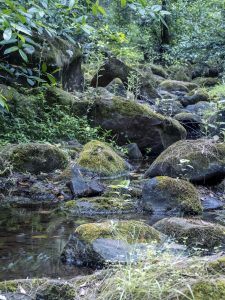
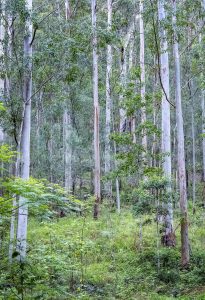

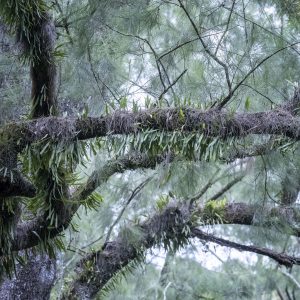
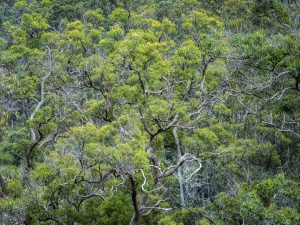 property owner is keen to explore the large range of possible management options. It was a relaxed and happy group that walked along the creek looking at the rainforest regrowth. Happy to be invited into such a wonderful property and great to be able to socialise and talk over a long picnic lunch. A smaller group then walked to some of the drier areas of the property. An inspiring day visiting a property with such great ecological and other values with an property owner equally enthusiastic about the potential of the property. Thanks for allowing us into this valuable area. Photos by Heather Miles. Used with permission.
property owner is keen to explore the large range of possible management options. It was a relaxed and happy group that walked along the creek looking at the rainforest regrowth. Happy to be invited into such a wonderful property and great to be able to socialise and talk over a long picnic lunch. A smaller group then walked to some of the drier areas of the property. An inspiring day visiting a property with such great ecological and other values with an property owner equally enthusiastic about the potential of the property. Thanks for allowing us into this valuable area. Photos by Heather Miles. Used with permission.
Wingham September 2020
This property had been visited by HFFN members 12 months previously to view areas being rehabilitated. Shortly after this visit the property was severely affected by fire so a later visit was planned to look at the damage caused by fire, the prospects of regrowth and to discuss best practise in assisting this forest back to a healthy status.
Around 20 members visited and the landholder gave an overview of the property type and species of trees occurring, as far as they knew, at various levels and in various sections. The extreme fire damage was illustrated with photos and video demonstrating both the immediate fire damage and various stages of regrowth and problems faced with prolific weed growth following subsequent flooding. It could be seen that, as expected, smoother barked trees such as Flooded Gums and Blue Gums were more severely damaged than the rougher barked Tallowwoods and Bloodwoods. Any saplings under about 3 metres were killed off in the fire.
After lunch and a very friendly catch up and meeting of new friends, we returned to an area that we had visited previously which was part way through the rehabilitation process following clear fell logging practises in the past and the subsequent prolific Lantana, Cissus vine, Wild Tobacco etc. rampant growth. On the way we walked through the rainforest area much of which was badly burnt. On the previous visit it was noted that while the vegetation was relatively lush the forest floor was very dry.
The rehabilitation area had been completely razed to the ground by fire. Part of it was still lightly vegetated before the fire but the ground was covered with dried lantana debris which had been deliberately left as mulch during the dry. This must have provided the fuel for the intense fire. In the adjacent older more mature rehabilitation area pencil cedar trees up to 10m tall did not survive the fire.
There were some promising signs of the beginnings of native regrowth in some areas together with some plantings which had done to hopefully help things along.
Very helpful and interesting discussions were held concerning what to leave, what to keep, what to not worry about too much and what to endeavour to remove to help the forest to return to a viable and stable forest. There was also interesting discussion on whether to selectively remove some regrowth to enable faster growth of the strongest trees or whether to let nature do its own thing. Some identification of some previously unseen plants by HFFN members was also really valuable.
All in all this was a great fun day with lots of helpful discussion on species identification and helpful hints on how to manage the forest’s rehabilitation.
HFFN Study Trip to the ACT
On the weekend of Sept 21-22 a group of HFFN members enjoyed a very interesting and informative visit to the Australian National Botanic Gardens and the National Arboretum in Canberra.
The trip kicked off Saturday morning at the National Botanic Gardens, beginning with a guided tour led by a remarkably experienced retiree volunteer. John was a professional forester, having worked in the UK, then west coast US forests, followed by moving to Australia where he worked in pine plantations in South Australia, and to Canberra where he completed his research PhD on Queensland eucalypts, later working at the CSIRO and in PNG forestry. John’s insights into the gardens were exemplary.
The 90-hectare National Botanic Gardens were first planned and planted in 1945, on sandy clay pasture with only a few scattered eucalypts, some of which still remain. It features almost entirely native Australian plants with diverse vegetation types.
Our tour took us past many interesting specimens such as the smallest known eucalypt E. vernicosa, Quandong (Santalum acuminatum) which is parasitic and dependant on establishment via a host species (e.g. Acacias), a massive E. scoparia which had grown over a stream fissure, and several Antarctic beech (Nothofagus cunninghamii).
We spent considerable time at the Eucalypt Lawn which had a broad collection of species. One impressive species was the Gympie Messmate (E. cloeziana), which we heard is the most important and resilient timber species of central and north Queensland, probably with potential in the Hunter. We also saw the Hilltop gum (E.michaeliana) which in ACT trials was voted #1 most promising new street tree. Some species were in good condition but there were also a number of others with poor form and which struggled with thinning crowns etc, due to the Canberra frosts, and the intermittent dry and wet soil caused by occasional irrigation. Other parts of the garden had issues with phytophthora, leading to removal of several advanced trees.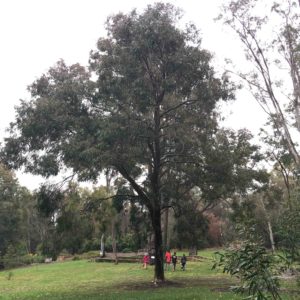
One of the highlights of the Garden was walking through the Rainforest Gully during a rain shower (with our raincoats and one umbrella). A welcome change from recent conditions in the Hunter and mid-north coast! The Rainforest Gully was a dry old creek bed converted into a garden of tree ferns and diverse rainforest shrubs and trees, aided by year-round irrigation misting – a luxury afforded by the waters of Lake Burley Griffin.
Saturday night we enjoyed a casual meal and relaxed evening at the Belconnen Soccer Club, before an early start at the National Arboretum on Sunday.
The 250-hectare National Arboretum was designed and planted after the devastating 2003 Canberra bushfires, conceived as a collection of “100 forests” of distinctive species from across the world. Each forest is a collection of 300-500 trees, planted over an area of around two hectares. The strong diplomatic connections in Canberra guided the selection, with many national or iconic trees representing respective nations or regions. The many exotic species include the Chilean cedar (Austrocedrus chilensis), Turkish pine (Pinus brutia), Japanese Zelkova (Zelkova serrata), Chinese tulip tree (Liriodendron chinense), Mesa Oak (Quercus engelmannii, USA), and English Oak (Quercus robur). There were also several native forests, including the Wollemi pine, Bunya pine, Kurrajong, and for some reason the white cedar (Melia azedarach).
Trees in each forest were typically planted 3-8 metres apart, in patterns of arcs, grids, or concentric circles, and often contoured across hillsides. The eucalypt forests (e.g. E. benthamii, E.tricarpa) were being managed for aesthetic and conservation reasons rather than forestry i.e. no branch thinning etc.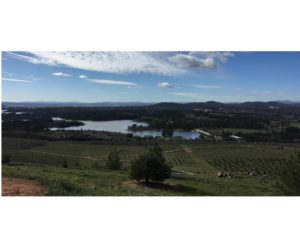
We also toured an integrated ecosystem garden, ‘STEP’ (Southern Tablelands Ecosystem Park), showcasing a range of trees, shrubs, flowers, and grasses native to the Canberra region.
The National Arboretum is still young, but is already impressive and in time should be wonderful. Its vast visitors’ centre features a cafe/restaurant with sweeping landscape views across to Lake Burley Griffin, and was very popular during our visit, much more so than the National Botanic Gardens. Hopefully the Arboretum will inspire many people of all ages to take an interest in trees and promote a legacy of tree planting and care.
Overall a very worthwhile and memorable trip, a big thanks to Trevor Woolley for so effectively planning and organising the event!
Tyrone O’Neill
Bulahdelah August 2019
A hardy but enthusiastic group gathered for a day identifying Eucalypts. It was a day of cold and very strong wind, but our host had arranged a quiet sheltered valley and a warm fire. Scattered around the cleared area were 7 or 8 different mature Eucalypts. Some quite surprising specimens in what was, in a former life, a grazing paddock. Armed with books and references, the group went from tree to tree and saying thankyou to the wind gods who provided a prolific amount of buds and fruit ready to pick up from the ground. Thanks to Fred for his assistance on the day.
Dungog June 2019
Over 25 people arrived for the first of the years three planned field days on Plant Identification. Many of the group were new to HFFN and the day began with the usual convivial morning tea with a rather wonderful spread.
Plant Identification is a topic that has often been discussed by new members to HFFN, so experts were gathered to help new comers to enter the world of plant identification and the language of taxonomy. After an introductory talk on the basics on plant identification and the resources that are available, the group walked and talked plant ID from the basics on Eucalypts to Acacias and many others. Lunch and more discussion followed. Overall a very successful day with much positive feedback on the material presented.
Thanks to Judy and Anne for hosting the day.
Tocal Field Days 2019
The Tocal field days were a great success, despite the prevailing drought and ( would you believe it) the rain. Friday was the usual busy day with many landowners talking with the HFFN representatives. Saturday started in an interesting fashion with a heavy rain storm and a river flowing through the HFFN stand! No worries, we can handle that! Fortunately, all the display items had been covered and after a slight re-organisation, all was OK for a busy morning. Over 20 people expressed interest in HFFN during the weekend and they have been included on the on the HFFN mailing list. Many have joined our plant identification field days.
Wootton September 2018
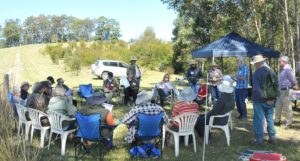 photo courtesy Patrick Riviere
photo courtesy Patrick Riviere
A warm sunny Spring day on 16 September 2018 saw a number of Hunter Farm Forestry members, visitors and local residents attend an inspiring field day at Wootton.
Fred and Sue are dedicated and knowledgeable members of the Hunter Farm Forestry Network. They purchased their property at Wootton a few years ago, devoid of trees and substantially degraded from decades of grazing. They had a vision, with solid planning, to re-vegetate a substantial portion of the property for tree species diversity, wildlife corridor and tree belt connectivity, with management of surface and subterranean water and soil quality.
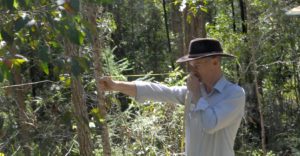 photo courtesy Patrick Riviere
photo courtesy Patrick Riviere
At an earlier field day at Wootton in April 2016, Fred and Sue explained the re-afforestation project for their scenic property. After 2 subsequent years of intensive ground preparation and tree planting, those fortunate to attend the field day in 2018 could see their hard work and careful planning come to fruition.
 photo courtesy Patrick Riviere
photo courtesy Patrick Riviere
They planted about 12.5 hectares with 15 types of eucalypts, 4 species of wattles and other trees all from the Hunter/North Coast region of NSW. Average rainfall for the area during the past 2 years was below average with some extended dry periods. Despite this, the survival rate for their plantings was around 90% with many over 3m high – a great outcome in what used to be open paddocks.
The property also had severe frosts through the winter of 2018. It was very informative for all to see how the various tree plantings and native regrowth had responded in different locations and to identify the species that were most resistant to frost.
Throughout the day, Fred and Sue explained their tree species selection and sourcing and the techniques they employed for ground preparation, soil enrichment, planting from tubestock, fertilisation, watering and mulching to achieve their 90% tree survival rate. The day concluded with an inspection of some of the forestry tools and equipment that Fred and Sue found to be most useful in their re-afforestation project.
Seaham June 2018.
On cool and bright winters day, a number of enthusiastic and energised foresters gathered for a walk and talk through Little Brandy Hill, primarily Ironbark-Spotted Gum forest.
The intention for the day was a talk through the basics of Tree Management – basal area, thinning and pruning. Primarily, this was schedule as a follow-up to the recent Tocal Field Days. As always, the day opens with an explanation by the landholder of “What’s Important to Us?”
There were many good examples of areas that required thinning, in order to set up the right conditions for diameter growth.
The walk continued through Grey Box and Spotted Gum areas that were set up for pruning demonstrations. A site was also set up to demonstrate chemical thinning with Tordon and axe.
A number of areas were highlighted of big ironbark growth, showcasing the real potential for similar growth of current stems, if managed appropriately.
The walk progressed through the rolling stringybark paths, including a stop at to observe the ancient grass trees, with a view through the canopy from above.
A further demonstration site was set up to showcase how to high-prune to 6 metres. A great deal of conversation was had about the merits of ladders vs pole saws, petrol, electric etc.
A further walk continued to the site of trees pruned 3 years ago, to see the scars healing beautifully, and to check the diameter growth.
This included a practical example of a felled Ironbark, which had ‘piped’ right up the centre. This is not an uncommon defect in local Ironbark species, and it is important to be aware of this, as it affects potential value, depending upon the intended use of the product.
Lunch was had around a roaring fire, with much talk around the topics of the day.
Stroud May 2018
It was cold, windy and it rained, but it was an inspiring day. Andrew took us for a tour around his 10,000 acre forest and talked passionately about it’s management and future.
The property has been in Andrew’s family for generations and over that time has been logged and managed for timber production. As with so many similar forests, sustaining the forest to produce saw logs is complex and a very long term project. Andrew was open and honest about the challenges this represents.
The forestry industry has always been challenged by high grading, prices paid to landholders and contractors. Todays challenges are no different. Andrew plays an active part in managing the forest and the harvest and has an in depth knowledge of the forest industry. This is essential for all landholders if they are to keep their forest in good condition and get the returns that they deserve.
Lunch and morning tea were the usual social occasion and the warmth and protection of the house was appreciated by all.
Thanks Andrew and Meri for an inspiring day.
Martindale April 2018
Our first field day for 2018 had to be rearranged at the last minute, and indeed this visit to Martindale, in the Upper Hunter, did not disappoint.
Framed by stunning escarpments in a broad valley, this is indeed a picturesque corner of the Lower Blue Mountains.
Trevor and Marion steered a small, but very enthusiastic, group through there plantation areas, their regrowth areas, and their PVP, covering off all 4 points off the compass.
Previously a cattle property, it has not been without its challenges, one of which is regrowth management, now that the grazing herd is no longer in the ecosystem. This was a conscious decision made by Trevor and Marion, and on the drive to Martindale, it was so pleasant after thousands of acres of flat, bare grassland, to arrive at a well-balanced, tree-lined healthy looking farm.
After the social occasion that is the meet and greet, Trevor gave all a valuable “look back in time” by taking us to the plantation area that was well in to 2nd thinning. One of the great benefits of the network, is that it allows you to learn from others lessons, by understanding the current impact of decisions made many years ago.
A notable point was in order to have the most likelihood of success and a good degree of quality, the seedlings were grown from seed originally harvested directly off the property.
Trevor and Marion’s wealth of knowledge, and deep understanding and connection with their full landscape, means they acknowledge they would perhaps have made some decisions differently.
But how exciting to see the plantation areas at 2nd thinning, developing in to clean, straight wood. It was noted that it can be easy to focus on the stems, and neglect the understory, however these two are taking steps to address this by thinning and letting more light in to ground level.
One of the true highlights was Trevor’s in-depth explanation of the precision required for safe, collateral-damage-free timber felling, even with the smaller saplings that are removed during thinning. There is one right way do to so, and there are an infinite number of wrong ways, but there are no second chances.
An exceptional hill side stroll was next, which included locating some of the 7 wildlife camera’s that are installed on the property. This piece of land backs on to Wollombi National park, and as good custodians of the land, Trevor and Marion are looking for signs of pest wildlife, in addition to surveying the native fauna. A very good demonstration and explanation of wildlife cameras was provided, including, features, usage, ease of access, etc. Back at lunch, photos of native and feral wildlife were harvested off the memory cards, a process well worth pursuing to gain a better understanding of the total ecosystem that is the land that you steward.
After a further plantation section, we visited the regrowth management area, which had an over-abundance of Casuarina. Trevor described the process he was going through, and the reasons for doing so – valuable lessons for all.
A beautiful day, with an exceptional backdrop of lower Blue Mountain escarpments, and another successful, knowledge and conversation-filled day.
Thank you to Trevor and Marion for hosting at such short notice.

